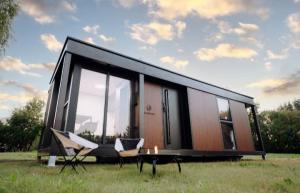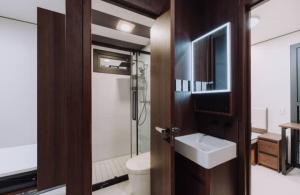How New-Gen ADUs Like Nestron’s Legend 2 Contribute to Housing Shortage Solutions
SINGAPORE, SINGAPORE, SINGAPORE, August 22, 2025 /EINPresswire.com/ -- As housing affordability continues to challenge urban regions across the U.S., policymakers and homeowners alike are increasingly turning to Accessory Dwelling Units (ADUs) as a way to ease the supply crunch. A new generation of modular ADUs like Nestron’s Legend 2 is offering more than just speed and scale; it's reshaping expectations for how these small homes can look, function, and fit into the architectural fabric of American neighborhoods.
Cities such as Los Angeles, Portland, and Austin have seen a surge in ADU permits over the past five years, as local and state governments loosen restrictions to encourage infill development. California has taken a leading role, passing a series of ADU friendly reforms that have made it easier and faster for homeowners to add small, detached units to their properties.
According to the California Department of Housing and Community Development (HCD), ADUs are “an innovative, affordable, and effective option for adding housing in California.” The agency’s 2025 https://www.hcd.ca.gov/sites/default/files/docs/policy-and-research/adu-handbook-update.pdf ADU Handbook notes that streamlining permits, reducing fees, and overriding certain zoning limitations has enabled https://cayimby.org/wp-content/uploads/2024/01/CAY-ADU_Report-2024-v4.pdf over 83,000 ADUs to be permitted across the state since 2016. Still, many of these structures have been built using traditional methods often leading to higher costs, longer timelines, and limited design diversity.
While the core function of ADUs remains the same adding a separate living unit on an existing residential lot companies like Nestron are shifting the conversation from mere utility to livability. The Singapore based firm specializes in fully assembled, modular homes designed to ship and install quickly, while also offering aesthetic and functional flexibility.
Nestron’s https://nestron.house (L2) model stands out among next gen ADUs for its compact footprint, modern silhouette, and adaptability to different urban and suburban environments https://nestron.house. Measuring just under 400 square feet, the unit is designed for efficiency without sacrificing design. It offers several interior layouts, multiple façade color options, and is delivered as a complete unit, reducing on-site construction disruption.
One of the biggest advantages of prebuilt modular units is the ability to control the construction environment. Unlike traditional builds that may take months and involve noisy on site work, modular homes like the Legend 2 are constructed in a factory setting and arrive nearly move in ready. This approach minimizes neighborhood disturbance, shortens build timelines, and ensures greater quality control.
“There's a lingering perception that modular means generic or impersonal,” says Lawrence XU, the CEO of Nestron. “The key to addressing the housing crisis lies in efficient production, cost-effective construction, and personalized, aesthetic design.”
Customization is also key to the growing appeal of modern ADUs. Nestron’s Legend 2 is available in two primary color schemes earthy darks and coastal lights making it easier to blend into regional landscapes, whether under a canopy of California oaks or against a sun soaked Florida lawn. Interior configurations include open studio plans or more private one bedroom layouts, making the unit suitable for a variety of uses: rental housing, guest homes, or independent living for aging parents.
This kind of design flexibility is particularly important in cities where neighborhoods vary dramatically in character and where zoning reforms have opened up formerly single family lots to increased density.
Construction costs have been one of the biggest variables in the housing sector over the last several years. Labor shortages, permitting delays, and supply chain disruptions have all contributed to budget overruns in traditional site-built projects. Modular ADUs provide an alternative.
With a base price starting around $65,000, the Legend 2 typically totals closer to $100,000 once delivery, site prep, and utility hookups are factored in still significantly lower than the cost of adding a traditional addition or building a new unit from scratch in most major markets.
This price point puts ADUs within reach for middle income homeowners looking to add generational housing or supplemental rental income. It also offers cities a relatively low cost tool for increasing housing supply without requiring massive infrastructure investments.
Because they are manufactured in a centralized facility, modular ADUs are uniquely positioned to scale both in production volume and geographic reach. The Legend 2 can be delivered across the continental U.S., with designs adapted for a variety of climate and code requirements, from snowy mountain regions to hurricane-prone coastlines.
That logistical predictability has made units like the Legend 2 particularly attractive in rural or exurban areas, where skilled construction labor may be limited and permitting processes can vary widely. It also aligns with broader policy goals: a 2023 analysis from the Terner Center https://ternercenter.berkeley.edu/research-and-policy/aligning-housing-with-climate-goals-the-importance-of-measuring-vmt/ for Housing Innovation at UC Berkeley highlighted modular housing as a critical path to meeting California’s 2.5 million housing unit target by 2030.
While ADUs are often framed as simple secondary structures, advocates argue they represent something more fundamental: a shift in how Americans think about urban density and flexible living. “When cities approve ADUs, they’re not just saying yes to a second structure they’re endorsing a more adaptable model of urban growth,” says a planner in Portland’s Bureau of Planning and Sustainability. “When these units are thoughtfully designed, they’re easier to integrate, and the public tends to be more supportive.” Portland’s Bureau of Planning and Sustainability: https://www.portland.gov/ppd/residential-permitting/home-projects/accessory-dwelling-units
That’s a significant evolution from just a few years ago, when the term “granny flat” evoked little more than a cramped converted garage. Today’s modular ADUs, from firms like Nestron and others, are helping to reframe what small-scale housing can be: sustainable, scalable, and even beautiful.
Cities such as Los Angeles, Portland, and Austin have seen a surge in ADU permits over the past five years, as local and state governments loosen restrictions to encourage infill development. California has taken a leading role, passing a series of ADU friendly reforms that have made it easier and faster for homeowners to add small, detached units to their properties.
According to the California Department of Housing and Community Development (HCD), ADUs are “an innovative, affordable, and effective option for adding housing in California.” The agency’s 2025 https://www.hcd.ca.gov/sites/default/files/docs/policy-and-research/adu-handbook-update.pdf ADU Handbook notes that streamlining permits, reducing fees, and overriding certain zoning limitations has enabled https://cayimby.org/wp-content/uploads/2024/01/CAY-ADU_Report-2024-v4.pdf over 83,000 ADUs to be permitted across the state since 2016. Still, many of these structures have been built using traditional methods often leading to higher costs, longer timelines, and limited design diversity.
While the core function of ADUs remains the same adding a separate living unit on an existing residential lot companies like Nestron are shifting the conversation from mere utility to livability. The Singapore based firm specializes in fully assembled, modular homes designed to ship and install quickly, while also offering aesthetic and functional flexibility.
Nestron’s https://nestron.house (L2) model stands out among next gen ADUs for its compact footprint, modern silhouette, and adaptability to different urban and suburban environments https://nestron.house. Measuring just under 400 square feet, the unit is designed for efficiency without sacrificing design. It offers several interior layouts, multiple façade color options, and is delivered as a complete unit, reducing on-site construction disruption.
One of the biggest advantages of prebuilt modular units is the ability to control the construction environment. Unlike traditional builds that may take months and involve noisy on site work, modular homes like the Legend 2 are constructed in a factory setting and arrive nearly move in ready. This approach minimizes neighborhood disturbance, shortens build timelines, and ensures greater quality control.
“There's a lingering perception that modular means generic or impersonal,” says Lawrence XU, the CEO of Nestron. “The key to addressing the housing crisis lies in efficient production, cost-effective construction, and personalized, aesthetic design.”
Customization is also key to the growing appeal of modern ADUs. Nestron’s Legend 2 is available in two primary color schemes earthy darks and coastal lights making it easier to blend into regional landscapes, whether under a canopy of California oaks or against a sun soaked Florida lawn. Interior configurations include open studio plans or more private one bedroom layouts, making the unit suitable for a variety of uses: rental housing, guest homes, or independent living for aging parents.
This kind of design flexibility is particularly important in cities where neighborhoods vary dramatically in character and where zoning reforms have opened up formerly single family lots to increased density.
Construction costs have been one of the biggest variables in the housing sector over the last several years. Labor shortages, permitting delays, and supply chain disruptions have all contributed to budget overruns in traditional site-built projects. Modular ADUs provide an alternative.
With a base price starting around $65,000, the Legend 2 typically totals closer to $100,000 once delivery, site prep, and utility hookups are factored in still significantly lower than the cost of adding a traditional addition or building a new unit from scratch in most major markets.
This price point puts ADUs within reach for middle income homeowners looking to add generational housing or supplemental rental income. It also offers cities a relatively low cost tool for increasing housing supply without requiring massive infrastructure investments.
Because they are manufactured in a centralized facility, modular ADUs are uniquely positioned to scale both in production volume and geographic reach. The Legend 2 can be delivered across the continental U.S., with designs adapted for a variety of climate and code requirements, from snowy mountain regions to hurricane-prone coastlines.
That logistical predictability has made units like the Legend 2 particularly attractive in rural or exurban areas, where skilled construction labor may be limited and permitting processes can vary widely. It also aligns with broader policy goals: a 2023 analysis from the Terner Center https://ternercenter.berkeley.edu/research-and-policy/aligning-housing-with-climate-goals-the-importance-of-measuring-vmt/ for Housing Innovation at UC Berkeley highlighted modular housing as a critical path to meeting California’s 2.5 million housing unit target by 2030.
While ADUs are often framed as simple secondary structures, advocates argue they represent something more fundamental: a shift in how Americans think about urban density and flexible living. “When cities approve ADUs, they’re not just saying yes to a second structure they’re endorsing a more adaptable model of urban growth,” says a planner in Portland’s Bureau of Planning and Sustainability. “When these units are thoughtfully designed, they’re easier to integrate, and the public tends to be more supportive.” Portland’s Bureau of Planning and Sustainability: https://www.portland.gov/ppd/residential-permitting/home-projects/accessory-dwelling-units
That’s a significant evolution from just a few years ago, when the term “granny flat” evoked little more than a cramped converted garage. Today’s modular ADUs, from firms like Nestron and others, are helping to reframe what small-scale housing can be: sustainable, scalable, and even beautiful.
Lawrence xu Rong Tian
Nestron House
+1 3022173974
email us here
Visit us on social media:
LinkedIn
Instagram
Facebook
YouTube
X
Legal Disclaimer:
EIN Presswire provides this news content "as is" without warranty of any kind. We do not accept any responsibility or liability for the accuracy, content, images, videos, licenses, completeness, legality, or reliability of the information contained in this article. If you have any complaints or copyright issues related to this article, kindly contact the author above.



